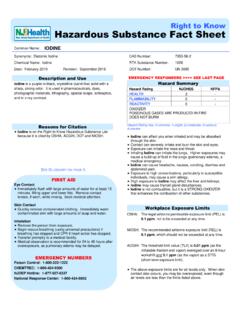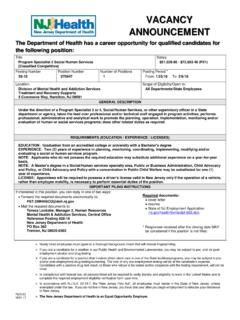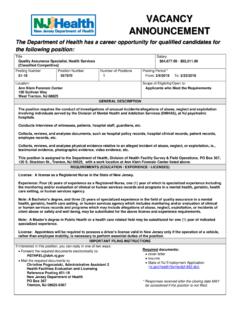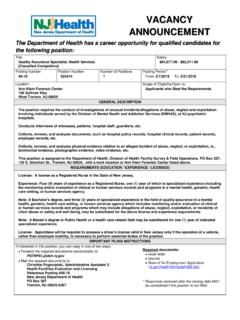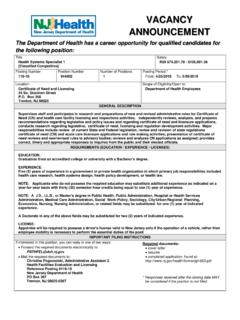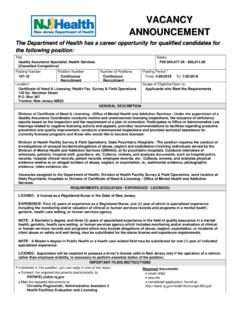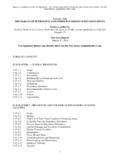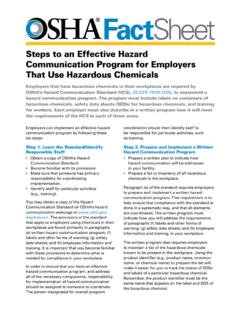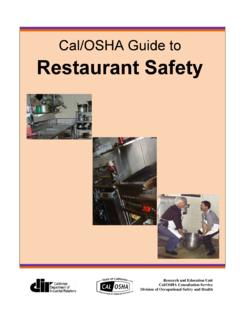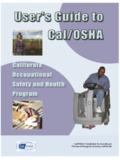Transcription of Right to Know Hazardous Substance Fact Sheet
1 Right to Know Hazardous Substance Fact Sheet Common Name: BENZENE. Synonyms: Benzin; Benzol; Phenyl Hydride CAS Number: 71-43-2. Chemical Name: Benzene RTK Substance Number: 0197. Date: October 2008 Revision: July 2015 DOT Number: UN 1114. Description and Use EMERGENCY RESPONDERS >>>> SEE BACK PAGE. Benzene is a clear, colorless liquid with a sweet Petroleum-like Hazard Summary odor. It is used as a solvent and in making plastics, resins, Hazard Rating NJDHSS NFPA. dyes and pesticides. It is also found in Gasoline. HEALTH 4 2. FLAMMABILITY - 3. ODOR THRESHOLD= 12 ppm REACTIVITY - 0. Odor thresholds vary greatly. Do not rely on odor alone to determine potentially Hazardous exposures. CARCINOGEN. FLAMMABLE. POISONOUS GASES ARE PRODUCED IN FIRE.
2 CONTAINERS MAY EXPLODE IN FIRE. Hazard Rating Key: 0=minimal; 1=slight; 2=moderate; 3=serious;. Reasons for Citation 4=severe Benzene is on the Right to Know Hazardous Substance List Benzene can affect you when inhaled and by passing because it is cited by osha , ACGIH, DOT, NIOSH, NTP, DEP, IARC, NFPA and EPA. through the skin. Benzene is a CARCINOGEN and MUTAGEN. HANDLE. This chemical is on the Special Health Hazard Substance List. WITH EXTREME CAUTION. Benzene can irritate the skin and eyes with drying and scaling of the skin. Inhaling Benzene can irritate the nose and throat. Benzene can cause headache, dizziness, nausea and vomiting. Convulsions and coma, or sudden death from SEE GLOSSARY ON PAGE 5. irregular heartbeat, may follow high exposure.
3 Repeated exposure can cause damage to the blood cells FIRST AID (aplastic anemia). Eye Contact Benzene is a FLAMMABLE LIQUID and a DANGEROUS. Immediately flush with large amounts of water for at least 15 FIRE HAZARD. minutes, lifting upper and lower lids. Remove contact lenses, if worn, while rinsing. Workplace Exposure Limits Skin Contact osha : The legal airborne permissible exposure limit (PEL) is Quickly remove contaminated clothing. Immediately wash 1 ppm averaged over an 8-hour workshift and 5 ppm, contaminated skin with large amounts of soap and water. not to be exceeded during any 15-minute work period. Inhalation Remove the person from exposure NIOSH: The recommended airborne exposure limit (REL) is Begin rescue breathing (using universal precautions) if ppm averaged over a 10-hour workshift and breathing has stopped and CPR if heart action has stopped.
4 1 ppm, not to be exceeded during any 15-minute Transfer promptly to a medical facility. work period. ACGIH: The threshold limit value (TLV) is ppm averaged EMERGENCY NUMBERS over an 8-hour workshift and ppm as a STEL. Poison Control: 1-800-222-1222 (short-term exposure limit). CHEMTREC: 1-800-424-9300. NJDEP Hotline: 1-877-927-6337 Benzene is a CARCINOGEN in humans. There may be no safe level of exposure to a carcinogen, so all contact should National Response Center: 1-800-424-8802 be reduced to the lowest possible level. The above exposure limits are for air levels only. When skin contact also occurs, you may be overexposed, even though air levels are less than the limits listed above. BENZENE Page 2 of 6. Determining Your Exposure Reproductive Hazard There is limited evidence that Benzene is a teratogen in Read the product manufacturer's Material Safety Data animals.
5 Until further testing has been done, it should be Sheet (MSDS) and the label to determine product treated as a possible teratogen in humans. ingredients and important safety and health information about the product mixture. Other Effects Benzene can cause drying and scaling of the skin. For each individual Hazardous ingredient, read the New Repeated exposure can cause damage to the blood cells Jersey Department of Health Hazardous Substance Fact (aplastic anemia). Sheet , available on the RTK website ( know/) or in your facility's RTK Central File or Hazard communication Standard file. Medical Medical Testing You have a Right to this information under the New Jersey Before first exposure and every 12 months thereafter, osha . Worker and Community Right to Know Act, the Public requires your employer to provide (for persons exposed to Employees Occupational Safety and Health (PEOSH) Act greater than ppm of Benzene) a work and medical history if you are a public worker in New Jersey, and under the and exam, which shall include: federal Occupational Safety and Health Act ( osha ) if you are a private worker.
6 Thorough physical examination Complete blood count (CBC). The New Jersey Right to Know Act requires most Any other tests determined necessary by the examining employers to label chemicals in the workplace and physician requires public employers to provide their employees with information concerning chemical hazards and controls. osha requires your employer to provide you and your doctor The federal osha Hazard communication Standard (29 with a copy of the osha Benzene Standard (29 CFR. ). CFR ) and the PEOSH Hazard communication Standard ( 12:100-7) require employers to provide Any evaluation should include a careful history of past and similar information and training to their employees. present symptoms with an exam. Medical tests that look for damage already done are not a substitute for controlling This Fact Sheet is a summary of available information exposure.
7 Regarding the health hazards that may result from exposure. Duration of exposure, concentration of the Substance and other Request copies of your medical testing. You have a legal Right factors will affect your susceptibility to any of the potential to this information under the osha Access to Employee effects described below. Exposure and Medical Records Standard (29 CFR ). Health Hazard Information Acute Health Effects The following acute (short-term) health effects may occur immediately or shortly after exposure to Benzene: Contact can irritate the skin and eyes. Inhaling Benzene can irritate the nose and throat causing coughing and wheezing. Benzene can cause headache, dizziness, lightheadedness, nausea and vomiting. Convulsions and coma, or sudden death from irregular heartbeat, may follow high exposure.
8 Chronic Health Effects The following chronic (long-term) health effects can occur at some time after exposure to Benzene and can last for months or years: Cancer Hazard Benzene is a CARCINOGEN in humans. It has been shown to cause leukemia. Many scientists believe there is no safe level of exposure to a carcinogen. BENZENE Page 3 of 6. Workplace Controls and Practices All protective clothing (suits, gloves, footwear, headgear). should be clean, available each day, and put on before work. Very toxic chemicals, or those that are reproductive hazards or sensitizers, require expert advice on control measures if a less toxic chemical cannot be substituted. Control measures Eye Protection include: (1) enclosing chemical processes for severely Wear indirect-vent, impact and splash resistant goggles irritating and corrosive chemicals, (2) using local exhaust when working with liquids.
9 Ventilation for chemicals that may be harmful with a single Wear non-vented, impact resistant goggles when working exposure, and (3) using general ventilation to control with fumes, gases, or vapors. exposures to skin and eye irritants. For further information on Wear a face shield along with goggles when working with workplace controls, consult the NIOSH document on Control corrosive, highly irritating or toxic substances. Banding at Do not wear contact lenses when working with this Substance . The following work practices are also recommended: Respiratory Protection Label process containers. Improper use of respirators is dangerous. Respirators Provide employees with hazard information and training. should only be used if the employer has implemented a written Monitor airborne chemical concentrations.
10 Program that takes into account workplace conditions, Use engineering controls if concentrations exceed requirements for worker training, respirator fit testing, and recommended exposure levels. Provide eye wash fountains and emergency showers. medical exams, as described in the osha Respiratory Wash or shower if skin comes in contact with a Hazardous Protection Standard (29 CFR ). material. Always wash at the end of the workshift. Where the potential exists for exposure over ppm, use a Change into clean clothing if clothing becomes NIOSH approved full facepiece respirator with an organic contaminated. vapor cartridge. Increased protection is obtained from full Do not take contaminated clothing home. facepiece powered-air purifying respirators.



